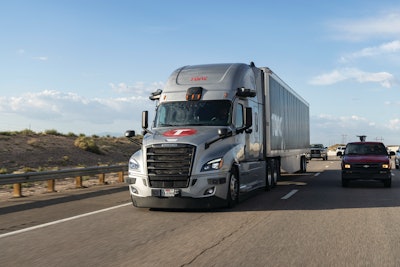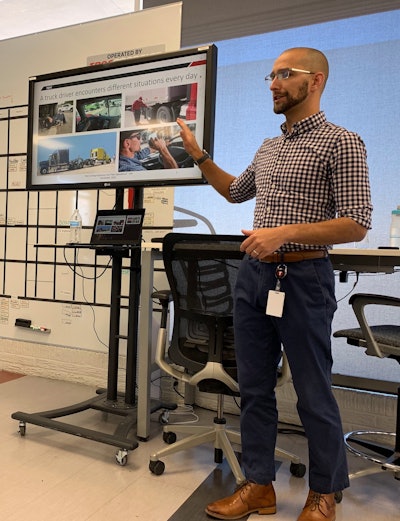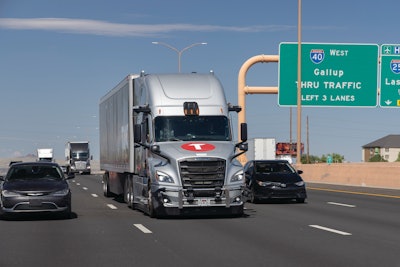Torc Robotics autonomous truck is boring — and that’s the way they like it.
The Daimler Truck subsidiary gave media a chance this week in Albuquerque, New Mexico, to experience its self-driving technology in a Freightliner Cascadia and true to design, it was mostly boring.
In other words, the sensor- and camera-adorned truck had no issues taking a 78,000 lb. load on a nearly hour-long round trip to a pretend hub location, which required negotiating bustling traffic along two highways and surface streets.
One cab attendant sat in the driver’s seat with his hands on the wheel while another sat to his right to help serve as another pair of eyes. Attendants are experienced truck drivers and carefully screened to ensure that they’re up to the task of helping guide along the eventual deployment of a Level IV system that doesn’t require attendants, which Torc expects by the end of the decade — or, as their execs and engineers repeatedly said, “when it’s safe.”
While Torc keeps its safety goals and technology pretty close to the vest (photos and video of the truck’s interior, the mission control screen and some presentation slides were not permitted), it’s clear that they’re focused on continually acquiring as much data as possible in the ongoing pursuit of safety and efficiency. Critical information not only comes from on-board and remote data systems, it also comes from veteran drivers inside the cab and personnel working back at what Torc calls mission control.
“We think that’s really important as much as you see the truck going down the road, all the other aspects of plugging into a freight network, or more elevated jobs of what a dispatcher or driver manager might do today are captured at mission control and a lot of other cool features too,” Torc’s Chief Strategy Officer Andrew Culhane told reporters before the test drives.
“We have the ability to get weather data back and forth to vehicles,” Culhane continued. “We have traffic information. We have a lot more that can make the promise of self-driving more meaningful and impactful for mission control.”
[Related: Autonomous truck spotted in the wild]
In a lot of ways, Torc’s approach is akin to a NASA operation, or air traffic control. Cutting edge technologies powered by Torc’s software doggedly analyze and respond to a long list of variables on the open road all while being overseen by razor sharp engineers driven to make long-haul trucking safer, more environmentally friendly and more profitable.
Getting there requires two driving shifts every day. Albuquerque was selected as Torc’s truck testing facility location in 2020 following Daimler Truck’s majority acquisition the year before. Busy traffic amid the popular freight corridors of I-40 and I-25, along with some challenging external factors like winter snowfall, rainy summer monsoons and occasional crosswinds, make the area ideal for testing.
 For the commercial rollout, sensors and cameras will undergo additional design improvements to help better withstand the rigors of road life. “We’re working on [automated] sensor cleaning right now,” said Chris Harrison, Torc’s vice president of platform development. “We have to have cleaning systems on board and algorithms that recognize when the sensor needs to be cleaned and if it’s acceptable reinitiate the cleaning cycle or decide to tell mission control, ‘Hey, at the hub I need this sensor to be cleaned because it’s 8% covered.’”Torc Robotics
For the commercial rollout, sensors and cameras will undergo additional design improvements to help better withstand the rigors of road life. “We’re working on [automated] sensor cleaning right now,” said Chris Harrison, Torc’s vice president of platform development. “We have to have cleaning systems on board and algorithms that recognize when the sensor needs to be cleaned and if it’s acceptable reinitiate the cleaning cycle or decide to tell mission control, ‘Hey, at the hub I need this sensor to be cleaned because it’s 8% covered.’”Torc Robotics
Heading out on the highway
On Tuesday afternoon, we were met with clear skies, a wind speed of roughly 5 mph and a temperature hovering just below 50 degrees Fahrenehiet.
The truck was in manual mode initially, which required the driver to take the truck from Torc’s spacious parking lot to nearby I-25. While making our way onto the on-ramp, a blue light came on at the top of the cab indicating that the truck had switched to autonomous mode.
Sitting in the back of the cab provided a clear view of the road ahead, along with an intriguing view of a monitor that offered a graphic recreation of the truck and surrounding traffic and objects as LiDAR, radar and cameras provide the critical inputs needed to help the truck find its way. In the meantime, mission control monitored the truck’s progress while its onboard autonomous system made all of the decisions regarding braking, acceleration, lane changes and stopping.
 Dain Rideau, product manager at Torc Robotics (shown above), explained that sensors and cameras on Level IV autonomous trucks will undergo pre-trip inspections. “The check becomes twofold. We still need to ensure that the sensor visually looks good but we obviously need the autonomous system itself to tell us that it’s good as well.”Commercial Carrier Journal
Dain Rideau, product manager at Torc Robotics (shown above), explained that sensors and cameras on Level IV autonomous trucks will undergo pre-trip inspections. “The check becomes twofold. We still need to ensure that the sensor visually looks good but we obviously need the autonomous system itself to tell us that it’s good as well.”Commercial Carrier Journal
“They call it a speed limit for a reason,” said Walter Grigg, program manager of product strategy at Torc who joined CCJ on the ride. “There’s a legal consequence to that, so we do not break it. I think it’s fair to say the virtual driver is very conservative.”
Since an autonomous truck does not have to stop for breaks or meals, driving a hair below the speed limit doesn’t concern Torc when it comes to making good time plus it helps conserve fuel and provides additional scope as the truck “constantly monitors the physics of the environment,” Grigg said.
Next, similar to what a driver would do, the truck determined the most optimal lane to travel for its next exit, in this case I-40. With another well-placed lane change we were on our way for a mostly uneventful ride — that is until a neighboring driver got a little squirrely, which as most truck drivers will attest, is pretty typical on the road.
In this case, a small sedan changed lanes fairly close in front of the truck. Though visually to this reporter it seemed like a pretty close lane change, the truck’s green zone on the monitor indicated that there was no need to apply the brakes. That’s something to keep in mind for fleets interested in preserving both brakes and fuel: you simply can’t beat a computer when it comes to saving both.
What came next though was really intriguing and served as an impressive reminder of just how far artificial intelligence has come in dealing with — let’s face it — the squirrel-brained human factor. As that compact sedan zipped up ahead about 20 yards or so and got on the tail of another driver, it was clear to the truck that this person was less than trustworthy. So, the truck decelerated to provide a bigger cushion between itself and the risky driver ahead. Grigg confirmed that the truck, much like a safety-conscious human driver, will look ahead at traffic and make adjustments as needed to mitigate risk. That was impressive.
As we approached the pretend hub off the interstate, the truck continued to handle the responsibility of driving. It easily detected traffic lights and proceeded or stopped accordingly. It made an impressive button-hook turn to the left at one intersection after it determined that it had a clear shot of briefly entering the adjoining lane. Other than that, it was fairly boring as the truck carefully and safely made its way, as all good drivers do, from Point A to Point B.
In this case, a hub model will serve as that critical Point A to B. Torc envisions drivers initially delivering loads from a large shipping destination, like a major port to a hub, where Freightliner trucks (Cascadias at first) equipped with Torc autonomous tech will drive the loads across major freight corridors to another hub. From there, human drivers will take the load to its final destination.
Torc, which was founded in 2005, leans on plenty of experience gleaned from working with the U.S. military over the years to develop self-driving technology that’s not only sturdy and dependable enough to get through challenging driving conditions, but also capable of succeeding on a lean budget. According to Torc CEO Peter Schmidt, who was previously the head of Daimler’s Autonomous Technology Group before joining Torc this year, Daimler was quickly won over by the tenacity and ongoing success of Torc’s team.
“We’ve made some bold decisions, and I think the biggest and most important one was really to buy Torc. It was absolutely the right decision,” Schmidt said.
Torc announced in September that it had entered a pilot program with Schneider which Culhane said Tuesday during a media briefing “has been underway for a couple weeks now. One [truck] just made it to Phoenix a few minutes ago.”
Schmidt beamed as he told reporters that the truck had “arrived four hours early.”
Culhane said the pilot with Schneider enables Torc “to make sure that we are learning with leaders in the industry and what it’s truly going take to adopt and integrate this technology.”
The opportunity also allows Torc to work on its plans for passing along the reins of mission control.
“We don’t intend on running a freight network of our own and running mission control,” Culhane continued. “There are experts in this world who are fantastic at how to run fleet operations, about how to deal with customers and booking and all of that. It would be foolish of us to think we can be better than them with that. So our job is to help build a product that enables them.”
 Dushyant Wadivkar, vice president of Torc’s system design & safety engineering, explained that Torc’s autonomous system has “built-in monitoring systems with very high precision to know instantly” that something is not functioning properly. “Step two is asking what to do next because not everything that is limited results in potentially stopping a vehicle, right?,” Wadivkar continued. “So we go through the design decision and ask, ‘Okay, what do we do next?’ One thing I can say without any hesitation is whatever we do we will always be safe and that we have to prove, right? That is a part of our design argument. That’s why the redundancy is important. That’s why multiple points of augmentation are important.”Torc Robotics
Dushyant Wadivkar, vice president of Torc’s system design & safety engineering, explained that Torc’s autonomous system has “built-in monitoring systems with very high precision to know instantly” that something is not functioning properly. “Step two is asking what to do next because not everything that is limited results in potentially stopping a vehicle, right?,” Wadivkar continued. “So we go through the design decision and ask, ‘Okay, what do we do next?’ One thing I can say without any hesitation is whatever we do we will always be safe and that we have to prove, right? That is a part of our design argument. That’s why the redundancy is important. That’s why multiple points of augmentation are important.”Torc Robotics
